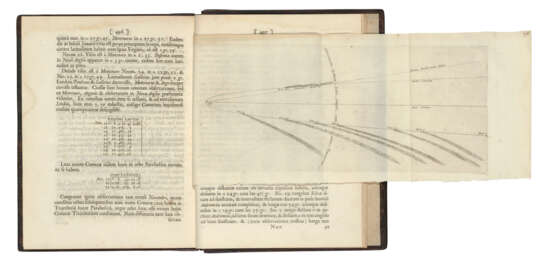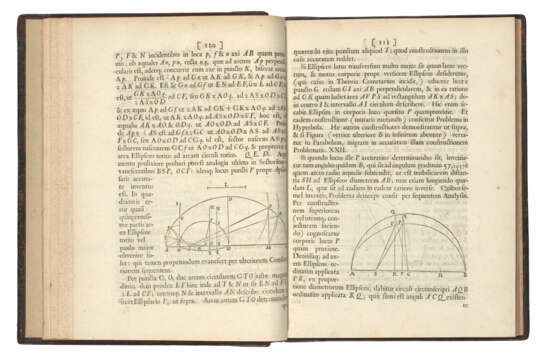ID 794384
Lot 170 | NEWTON, Sir Isaac (1642-1727)
Valeur estimée
£ 350 000 – 500 000
Philosophiae naturalis principia mathematica. Edited by Edmond Halley (1656-1743). London: Joseph Streater for the Royal Society [at the expense of Edmond Halley], to be sold by various booksellers, 1687.
First edition of ‘the greatest work in the history of science’ (PMM); ‘perhaps the greatest intellectual stride that it has ever been granted to any man to make’ (Einstein). The Principia elucidates the universal physical laws of gravitation and motion which lie behind phenomena described by Newton's predecessors Copernicus, Galileo and Kepler. Newton establishes the mathematical basis for the motion of bodies in unresisting space (the law of inertia); the motion of fluids and the effect of friction on bodies moving through fluids; and, most importantly, sets forth the law of universal gravitation and its unifying role in the cosmos. ‘For the first time a single mathematical law could explain the motion of objects on earth as well as the phenomena of the heavens. … It was this grand conception that produced a general revolution in human thought, equalled perhaps only by that following Darwin's Origin of Species’ (PMM). Newton’s scientific views were not seriously challenged until Einstein's theory of relativity and Planck's quantum theory, and his principles and methods remain essential for the solution of many scientific questions.
Halley encouraged the ‘Incomparable’ Newton to write the Principia (Newton acknowledges his contribution in the preface) and saw the work through the press, even bearing the cost of printing, since the Royal Society's funds had been depleted. The printing history of the Principia is well documented, and two issues are distinguished, based on the two states of the title-page: one with a 2-line imprint, as here, and one with a 3-line imprint naming the bookseller Samuel Smith, each reflecting domestic versus foreign distribution. The present copy belongs to the issue for distribution in Britain (two-line imprint), traditionally designated the first; Halley and Newton sold it through a number of unnamed booksellers. The other, smaller, issue was largely turned over to Samuel Smith for distribution on the continent and required a cancel-title (three-line imprint). The edition was divided between two compositors working concurrently, one setting the first two books, the other setting the third. W. Todd has identified a number of stop-press corrections, but they cannot be related to either issue.
Babson 6; Dibner 11; Grolier/Horblit 78 (‘the most influential scientific publication of the seventeenth century’); PMM 161; A.N.L. Munby, ‘The two title-pages of Newton's Principia’ in Notes and Records of the Royal Society 10 (1952); W. Todd's bibliography in Koyré & Cohen's ed. of Newton's Principia II, 851-3; Norman 1586 (3-line imprint title); PMM 161; Wallis 6; Wing N-1048.
Quarto (245 x 186mm). Folding engraving of cometary orbit bound at p.496, numerous woodcut diagrams. Title in first, 2-line imprint, state, uncancelled; P4 cancel correcting orientation of the diagram on verso, errata at end (without final blank Ooo4 as usual, paper flaw repaired in C1, occasional small spot or stain, faint occasional marginal dampstain from quire Zz, small marginal tear in Aaa1). Contemporary panelled calf, red sprinkled edges (rebacked, lightly restored, new endpapers); modern red morocco-backed box. Provenance: an early hand has incorporated corrections from the errata leaf (annotation occasionally just shaved) – other occasional annotation – discreet erasure on title verso.
Special Notice
No VAT on hammer price or buyer's premium.
| Artiste: | Isaac Newton (1643 - 1727) |
|---|---|
| Lieu d'origine: | Europe du Nord, Europe, Royaume-Uni |
| Catégorie maison de vente aux enchères: | Livres imprimés |
| Artiste: | Isaac Newton (1643 - 1727) |
|---|---|
| Lieu d'origine: | Europe du Nord, Europe, Royaume-Uni |
| Catégorie maison de vente aux enchères: | Livres imprimés |
| Adresse de l'enchère |
CHRISTIE'S 8 King Street, St. James's SW1Y 6QT London Royaume-Uni | |
|---|---|---|
| Aperçu |
| |
| Téléphone | +44 (0)20 7839 9060 | |
| Commission | see on Website | |
| Conditions d'utilisation | Conditions d'utilisation |





![[NEWTON, Isaac (1642-1727)]](/assets/image/picture_4036009/5c8e6/3e601c7a9444e346ef4136ceaf96156f1720562400jpg__fix_162_205.jpeg)








